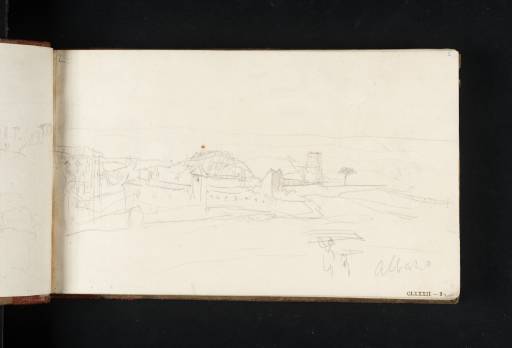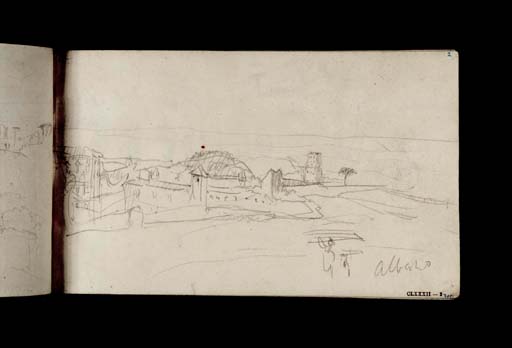Joseph Mallord William Turner View of Albano from the Via Appia 1819
Image 1 of 2
Joseph Mallord William Turner,
View of Albano from the Via Appia
1819
Joseph Mallord William Turner 1775–1851
Folio 2 Recto:
View of Albano from the Via Appia 1819
D15298
Turner Bequest CLXXXII 2
Turner Bequest CLXXXII 2
Pencil on white wove paper, 113 x 189 mm
Inscribed by the artist in pencil ‘2’ top left and ‘Albano’ bottom right
Inscribed by John Ruskin in blue ink ‘2’ top right and ‘301’ bottom right
Stamped in black ‘CLXXXII 2’ bottom right
Inscribed by John Ruskin in blue ink ‘2’ top right and ‘301’ bottom right
Stamped in black ‘CLXXXII 2’ bottom right
Accepted by the nation as part of the Turner Bequest 1856
References
1909
A.J. Finberg, A Complete Inventory of the Drawings of the Turner Bequest, London 1909, vol.I, p.536, as ‘ “Albano” ’.
1984
Cecilia Powell, ‘Turner on Classic Ground: His Visits to Central and Southern Italy and Related Paintings and Drawings’, unpublished Ph.D thesis, Courtauld Institute of Art, University of London 1984, p.194 note 102.
1987
Cecilia Powell, Turner in the South: Rome, Naples, Florence, New Haven and London 1987, p.[88] note 78.
This sketch depicts a view of Albano from the gate near the Via Appia, the road which leads from Rome to the south of Italy.1 The tower visible on the far right is a tomb, sometimes called the Tomb of Pompey, or Ascanius, a three-storey structure, approximately 45 metres in height which lies on the left of the road as soon as it enters Albano. The surface of the tower is punctuated by square blocks. Andrew Lumisden described it in 1812 as ‘the remains of a magnificent mausoleum ... incrusted with marble, and each story ornamented with columns, no doubt of different orders. Though robbed of these columns and the incrustation, yet the bells, or praecinationes of these stories, and the marble blocks to which they were fixed still remain, and point out its former state’.2 The tomb was recorded by Piranesi in his Antichità d’Albano e di Castel Gandolfo 1764,3 and in a 1796 drawing by Carlo Labruzzi, the artist who accompanied Richard Colt Hoare on his journey through Italy in 1789.4
Nicola Moorby
May 2008
The same view can be seen in a drawing by Charles Joseph Lecointe, see Francesco Petrucci e Susanna Marra, Vedute dei Colli Albani e di Roma dall’album di viaggio di Charles Joseph Lecointe (1824–1886), exhibition catalogue, Palazzo Chigi, Ariccia 2006, no.17, p.35, reproduced.
Reproduced http://www.romeartlover.com and see also http://www.museicivicialbano.it/circuito/sepolcroatorre accessed May 2008.
How to cite
Nicola Moorby, ‘View of Albano from the Via Appia 1819 by Joseph Mallord William Turner’, catalogue entry, May 2008, in David Blayney Brown (ed.), J.M.W. Turner: Sketchbooks, Drawings and Watercolours, Tate Research Publication, December 2012, https://www


